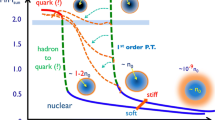Summary
By simple arguments, we have shown that Károlyházy’s model overestimates the quantum uncertainty of the space-time geometry and leads to absurd physical consequences. The given model can thus not account for gradual violation of quantum coherence and cannot predict tiny experimental effects either.
Similar content being viewed by others
References
F. Károlyházy:Nuovo Cimento A,42, 1506 (1966).
F. Károlyházy, A. Frenkel andB. Lukács: inPhysics as Natural Philosophy, edited byA. Shimony andH. Feschbach (MIT Press, Cambridge, Mass., 1982).
F. Károlyházy, A. Frenkel andB. Lukács: inQuantum Concepts in Space and Time, edited byR. Penrose andC. J. Isham (Clarendon, Oxford, 1986).
L. Diosi andB. Lukács:Phys. Lett. A,142, 331 (1989).
C. W. Minser, K. S. Thorne andJ. A. Wheeler:Gravitation (Freeman, San Francisco, Cal., 1973).
G. C. Ghirardi, A. Rimini andT. Weber:Phys. Rev. D,34, 470 (1986).
Author information
Authors and Affiliations
Rights and permissions
About this article
Cite this article
Diósi, L., Lukács, B. Károlyházy’s quantum space-time generates neutron star density in vacuum. Nuov Cim B 108, 1419–1421 (1993). https://doi.org/10.1007/BF02755193
Received:
Accepted:
Published:
Issue Date:
DOI: https://doi.org/10.1007/BF02755193




